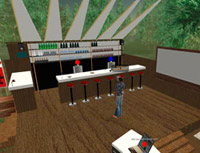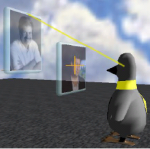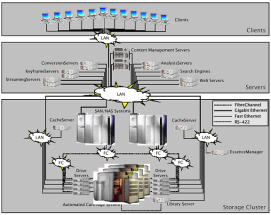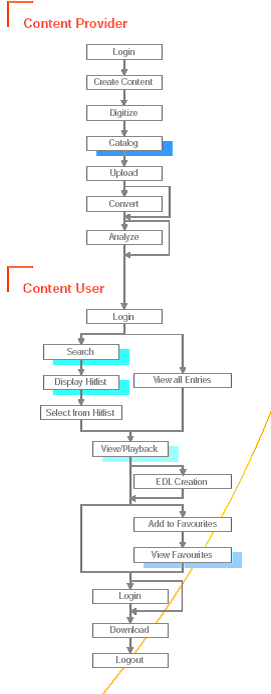Media and Virtual Worlds
- Virtual Worlds--Virtual Worlds
- Secondlife--What's wrong with Secondlife
- Enterprise Logging and Log Analysis--Uncanny valley and the biology of mind reading
- Document Construction--My work on Document Construction
Political and legal actions recently have shown that the virtual characteristics of modern media are a problem for a business still based on the principles of material carriers for the information. But creation, packaging, transport and reception are dramatically different to previous areas. Teaching at a university for media studies means to recognize these changes and create awareness for them.
On new developments in media and computing
- Virtual Worlds - Party or Content, more..
-
 The presentation of the HDM media jungle raised some heated discussions on design, goals and content (or its lack of). But do we know the language and rules of virtual worlds yet? On growing pains of technologies and media channels.
The presentation of the HDM media jungle raised some heated discussions on design, goals and content (or its lack of). But do we know the language and rules of virtual worlds yet? On growing pains of technologies and media channels. - Secondlife - making the virtual life work like real life
-
 Secondlife is just like Digital Restriction Management - a backward view on the possibilities of "being digital". It is important to separate the centralized business model from the the technical and social opportunities of virtual worlds. Are there distributed alternatives? SeeOpenCroquet Article from Heise News.
Secondlife is just like Digital Restriction Management - a backward view on the possibilities of "being digital". It is important to separate the centralized business model from the the technical and social opportunities of virtual worlds. Are there distributed alternatives? SeeOpenCroquet Article from Heise News.
- The problem of many speakers, more...
-
Events from our computer science and media faculty are frequently streamed into the internet. We have built a nice, mobile streaming solution. The only problem left is how to capture voices from the audience without having to run around with a microphone and yelling "stop, wait for the mic." at the speaker. I've got two ideas on how to solve this problem: balloon-microphones and the throwable multi-party microphone.
- The truth about techno bubbles
-
A techno bubble is an isolated space created artificially through the use of technical gadgets - thereby preventing face-to-face communication. The prototype is the teenager being attached to a walkman or mp3 player. Read about the heated discussion around this topic and the breaktrough discovery (by yours truly W.K.) that this anti-social behavior is in some cases caused by marsupials.
On all things related to games development
- Security in Online Worlds , more..
An excellent thesis by Martin Scheffler on the use of capability-secure languages in scene graphs. Shows the lambda based capability patterns like facet, forwarder and sealer/unsealer at work to allow anonymous, distributed and context dependent access control.
- 4th Games Day at HDM, designing virtual worlds , more..
 Desing and content, not raw technology are key in our 4th games day. Learn how to create virtual worlds. See live game demonstrations and discuss current and future trends in gaming and game industry.
Desing and content, not raw technology are key in our 4th games day. Learn how to create virtual worlds. See live game demonstrations and discuss current and future trends in gaming and game industry.- The things that make computer games playable, more..
-
No, it is not the latest in computer graphics that makes games successful - at least not the animation alone. Good games offer good game play mechanics - in other words good ways to interact with the game (and perhaps other players as well). But the mechanics are not enough by far. On top of this good balancing is required to make a game fun to play. Read the thesis by Thomas Fuchsmann to understand how games tick.(BTW: we call the person who has fun with a software game "player" - and we call the person who runs office software "user" - ever thought about this?)
- Games Day: We have gained a level, more...
-
Games Day results and plans for the future.
- Program for the First HDM Game Day, more...
-
 The Computer Science & Media Faculty at HDM and friends proudly present the program for the First HDM Game Day. Its goal is to provide a forum for game developers and interested parties to exchange ideas and learn about core techniques used in game development. (Screenshot courtesy of Fuchsmann/Radicke: FinalStarfighterDeluxe)
The Computer Science & Media Faculty at HDM and friends proudly present the program for the First HDM Game Day. Its goal is to provide a forum for game developers and interested parties to exchange ideas and learn about core techniques used in game development. (Screenshot courtesy of Fuchsmann/Radicke: FinalStarfighterDeluxe)
- Blog for a job - how blogging can help you
-
I have always urged my students to create a homepage with their works as a reference. But a blog might even be more important. My friend Sam Anderegg who visited OSCOM last week learnt some unexpected things on blogs there.
- O'Reilly Emerging Technology Conference
-
There is little to be envious about in the US nowadays - except that one conference. I wonder why we can't get something alike going in Europe? But then again - istn't it already hard to find people willing to engage in a discussion about future topics even at the university?
Interactive rooms for interacting groups, more...? The classic university lecture is long dead. But at least in computer science it is hard to run interactive seminars which include e.g. source code studies etc. The technology seems to get into our way here. But I might have seen a solution today: interactive rooms. (need to get a link to the Stanford video)
Mediaspace - a next generation augmented room, more...?
A followup to my wishlist for interactive rooms to better support software studies. The articel describes what happens in Jan Borchers group at the RWTH Aaachen (computer science and media)
I just finished a larger study on media asset management and business TV for a large company. The situation with respect to rich media in companies is currently like this: There are four levels of understanding necessary for dealing successfully (means with respect to resonably production costs, good and cheap transport and creating a value at the recipient side) with rich media and most companies still have a long way to go. The
The first level deals mostly with streaming media issues in intranets and on the internet. Most company internal networks could nowadays carry rich media streaming content or could be enhanced to do so using technology like CISCO's ACNS or embedded mpeg streamers etc. Automation of this technology is still a problem.
The second level deals with content management issues. Companies realize after a while that they are creating huge data graves of rich media. Most have a content management system for textual information but they store rich media on file systems, creating search and re-use problems. The problem on this level was and is that professional archive technology e.g. from broadcast companies is too expensive for regular companies. But systems like Media Archive from tecmath AG could be scaled down. The problem is to make the companies realize that they have an archive problem.
The third level is reached when a company realizes that content is the real problem. When Video on demand is becoming a necessity because of usability reasons. When companies no longer use global channel to broadcast very specific information which is only interesting for a small selection of their employees. When the company questions effectivity of rich media. When the differences between professional news presentations and home-grown solutions are realized. When the company realizes that there are political issues behind content. (I owe this to Johannes Schaugg from our audio/visual faculty who made me switch my focus from technology to content). E-learning e.g. needs a good understanding of content and reception of rich media is far from easy.
The last level is reached when the company is able integrate rich media into company communications. Self-service technology is implemented and supports collaboration between groups of employees and also to customers. The company has an internal policy that allows information sharing and therefore interesting and valuable newscasts. One of the companies which are pretty far on this track is probably CISCO which uses rich media a lot for internal and external use (there is an excellent article on http://www.streamingmedia.com on CISCOs internal use.
Digital media touches every level of software and hardware development. From real-time requirements in process control to optimized file system design. From streaming protocols like RTSP to encryption and description technology like MPEG4. The trend to meta-data for media will become even stronger and the small and embedded devices like smartphones will become important rich media players.
Students develop all kinds of media software at HDM, e.g. MPGE4 editors, streaming media packages, content management systems etc. Even funny projects like turning network packets into audio have surprisingly useful applications. Music players on mobile devices are becoming increasingly more important as well.
- MPEG4
-
A very nice MPEG4 editor has been developed by Markus Brenner. You can find it here: MP4UI on sourceforge
- Audiospaces and the new MACs, more ...
-
Stefan Werner is doing something really hot on the new MACs: building an interactive audiospace. The project requires extensive architectural knowledge (user space drivers, audio APIs etc.) as well as excellent audio know how.
Some resourcs for automated tests etc.
- OLAT online learning and training, more ...
-
Interested in an open source training package with automated examinations? Check out this idea!
New business models for new media
- A business model for online music, more...
-
Inspired by Clay Shirky's latest newsletter where he claims that the music industry is indirectly pushing encryption technology to new heights I started thinking about how a business model for the music industry could work.
- Is there more to user interface design than Model-View-Controller, more...?
-

Looks like our usability workshop was quite a success. Here are some ideas about what could be done to improve developer awareness. In the summer term we will make a workshop on usability in mobile computing. Contact me if you'd like to present something.


